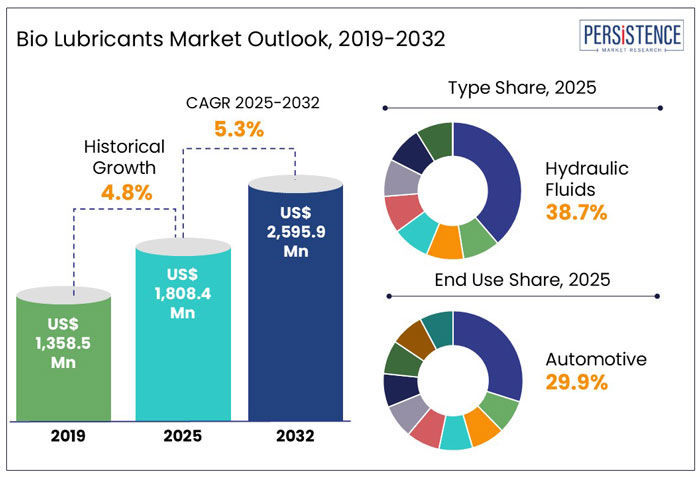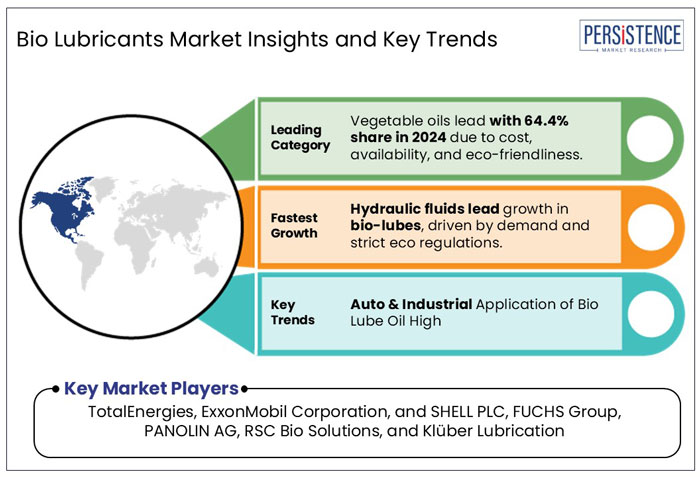ID: PMRREP12157| 250 Pages | 30 Apr 2025 | Format: PDF, Excel, PPT* | Chemicals and Materials

According to Persistence Market Research, the global bio lubricants market was valued at around US$ 1,808.4 Mn in 2025. reaching US$ 2,595.9 Mn at a CAGR of 5.2% by 2032. Expansions in automotive, aerospace, and construction industries are expected to play a crucial role in driving demand, as stringent environmental regulations push manufacturers toward sustainable alternatives.

|
Global Market Attribute |
Key Insights |
|
Bio Lubricants Market Size (2019A) |
US$ 1,358.5 Million |
|
Bio Lubricants Market Size (2025E) |
US$ 1,808.4 Million |
|
Projected Year Value (2032F) |
US$ 2,595.9 Million |
|
Global Market Growth Rate (2025-2032) |
US$ 5.3% |
|
Collective Value Share: Top 3 Countries (2025E) |
56.8% |
The automotive sector, with 74.6 million global car sales in 2024, continues to be a key contributor. Growing vehicle production in China, North America, and the EU highlights increasing demand for high-performance lubricants, particularly in electric vehicles and hybrid systems. Meanwhile, the U.S. aerospace and defense sector with US$955 billion in sales in 2023, presents strong opportunities for advanced lubricant formulations tailored to precision engineering.
The construction industry, projected to reach US$15.5 trillion by 2030 is another major growth driver. Expanding infrastructure development in China, India, and the U.S. requires heavy machinery and industrial equipment, fueling demand for eco-friendly lubricants. As sustainability gains traction, manufacturers are integrating plant-based and biodegradable solutions to comply with the evolving regulatory frameworks, strengthening market penetration across key end-use segments.
Bio engine oils are gaining significant traction as they are widely accepted as petroleum-based oil replacements. This promises to have a favorable influence on the environment and will aid in the resolution of associated issues. Renewable raw materials such as plant oils and animal fats are being utilized. Vegetable oil-based lubricants are known to provide a lot of environmental and long-term advantages over petroleum-based alternatives. They are also more cost-effective and have a higher degree of biodegradability.
New lubricants are altered multiple times before dumping into the environment. The need for biodegradable, bio-based lubricants has increased as there is a heightened public awareness of the environmental implications of mineral oil-based lubricants.
The bio lubricants market has experienced the rising need for sustainable polymer and urethane applications, driven by increasing adoption of bio-based and recycled materials. In 2023, Emery Oleochemicals’ launched EDENOL® 2178 and EDENOL® 2192 highlight the shift toward eco-friendly plasticizers, catering to the rising demand for bioplastics and PVC alternatives. Similarly, INFIGREEN® 420R, a recycled polyester polyol, sharpens the focus on circular economy solutions, offering improved mechanical properties and hydrolytic resistance for urethane applications.
With the rapid expansion of the electric vehicle (EV) industry, the demand for specialized lubricants and fluids is accelerating, creating an opportunity for high-performance ester base stocks. In 2024, Emery Oleochemicals’ launched its DEHYLUB® portfolio introducing advanced EV fluids, addressing challenges such as oxidative stability, heat dissipation, and lubricity. As automakers prioritize sustainability and efficiency, bio-based and synthetic ester-based lubricants will play a key role in optimizing EV performance.
For bio-lubricant manufacturers, the market is hampered by the high cost of bio-lubricants and low-quality lubricating properties. Vegetable oil-based lubricants are biodegradable to a great extent, making them a suitable alternative to conventional lubricants. Their direct usage as base oils is limited due to their low oxidative qualities and poor low-temperature capabilities, which contribute to higher prices, contamination, and biodegradability losses. As a result, developing cost-effective bio-lubricants with a breakthrough mix of biodegradability and high lubricant characteristics is a huge task.
The price of these lubricants is a significant barrier for the market to overcome. In comparison to a regular lubricant, a bio lubricant is 30-40% more expensive. Most bio-based products are priced to compete with mid-to-high performance mineral oil products. These factors are estimated to impact market growth to a certain extent in the coming decade.
Hydraulic fluids hold the highest market share in the bio-lubricants segment due to their widespread adoption across industries such as construction, manufacturing, and automotive.
The emphasis on sustainable and high-performance lubricants drives demand for biodegradable hydraulic oils. For instance, in June 2023, Performance Biolubricants and OMS LubriTek in June 2023 made OMS - MI240 HYDRAULIC Service Partner. MI240 is a biodegradable synthetic ester-based hydraulic fluid that significantly reduces particle contamination in plastic moulding equipment by over 80% in field trials. This highlights the increasing preference for eco-friendly hydraulic solutions in industries where fluid quality and environmental impact are critical.
The automotive sector leads the adoption of Eco-Friendly lubricants due to the rising global vehicle sales and an increasing regulatory pressure for sustainable solutions. In 2023, global car sales grew by nearly 10%, surpassing 72 million units as supply chain disruptions eased. Europe saw an 18.6% increase, while North America recorded 15% growth, with U.S. sales rising by 14.4%. Asia remained a dominant force, with China accounting for 31% of global sales and India reaching a record 4.2 million units. This surge in vehicle production and sales has driven the demand for high-performance, biodegradable lubricants across various automotive applications.

China’s expanding automotive sector is driving demand for advanced lubricant solutions with vehicle production and sales surging in early 2025. Passenger vehicle output reached 1.785 million units in February, marking a 40.2% y/y rise, while new energy vehicles (NEVs) witnessed a remarkable 91.5% y/y growth in production. As automakers prioritize efficiency and sustainability, the shift toward high-performance lubricants is accelerating, particularly in NEVs that require specialized formulations for thermal management and reduced wear. The industrial sector including commercial vehicles experienced a steady growth with production climbing 36.6% y/y, reinforcing the need for advanced fluid technologies.
Export growth further amplifies this trend, with China shipping 441,000 vehicles in February, including 131,000 NEVs—a 60.5% y/y increase. With the rise of fuel-efficient powertrains and stringent environmental regulations, manufacturers are focusing on advanced lubrication technologies to enhance vehicle longevity and operational efficiency. The increasing use of sustainable base oils in domestic manufacturing and exported vehicles positions China as a key market for innovation in automotive fluids, aligning with global sustainability goals.
The U.S. automotive industry is a key driver for advanced lubrication technologies, with light truck sales reaching over one million units in February 2025. While passenger car sales saw a decline, demand for hybrid vehicles surged due to potential changes in federal tax credits. This shift is increasing the need for high-performance lubricants tailored to hybrid and electric powertrains. Additionally, ongoing supply chain uncertainties and potential tariff hikes on steel and aluminum may drive domestic manufacturing investments, further fueling demand for specialized lubrication solutions.
Beyond automotive, the aerospace sector’s growth, reached US$955 billion in sales in 2023, and the construction industry’s US$2.2 trillion market in 2024 underscore the rising need for high-efficiency lubrication across multiple verticals. With the U.S. oil and gas industry producing 13.3 million barrels per day by the end of 2023, energy sector advancements also contribute to increasing adoption of sustainable lubricant formulations. As industries prioritize efficiency, performance, and regulatory compliance, the market for eco-friendly lubrication technologies is set to expand, driven by evolving industrial demands.
The bio lubricants market is fragmented with numerous companies focusing on sustainable lubrication solutions through acquisitions, product launches, and technological advancements. Leading players such as Shell, TotalEnergies, and ExxonMobil are expanding their portfolios with biodegradable and energy-efficient formulations, aligning with net-zero goals.
Mid-sized firms such as BioBlend Renewable Resources and Emery Oleochemicals are strengthening their positions through strategic acquisitions and innovative ester-based additives.
Partnerships, such as ExxonMobil’s collaboration with BioAccelergy Ventures, highlight the emphasis on scalable bio-based feedstock production. The industry is witnessing increased investments in biodegradable formulations for EVs, industrial applications, and power distribution, fostering competition among established players and emerging innovators.
The market is projected to witness a CAGR of 45.3% growing from US$ 1,808.4 Million in 2025 to US$ 2,595.9 million by 2032.
The Hydraulic Fluids segment held a share of 38.7% in 2024.
North America & Europe are poised to dominate the market during the forecast period.
Automotive Segment is expected to capture a significant share of 29.9% by 2024.
The leading players in the bio-lubricants market include TotalEnergies, ExxonMobil Corporation, and SHELL PLC, which dominate the market with extensive product portfolios and global distribution networks. Other key players include FUCHS Group, PANOLIN AG, RSC Bio Solutions, and Klüber Lubrication.
|
Report Attribute |
Details |
|
Forecast Period |
2025-2032 |
|
Historical Data Available for |
2019-2024 |
|
Market Analysis |
US$ Mn for Value, Tons for Volume |
|
Key Regions Covered |
|
|
Key Market Segments Covered |
|
|
Key Companies Profiled |
|
|
Customization and Pricing |
Available upon Request |
By Product Type:
By Raw Material:
Bio Lubricants Market by End-Use:
Bio Lubricants Market by Region:
Delivery Timelines
For more information on this report and its delivery timelines please get in touch with our sales team.
About Author